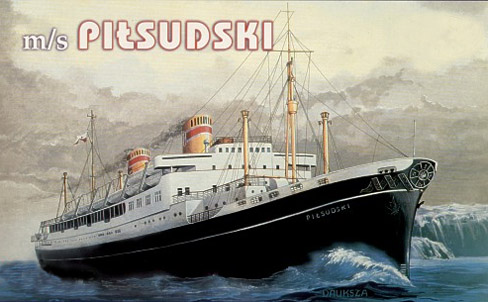
M/S Pilsudski
This was the first of the two ships to be commissioned, her keel was laid down in March 1934 and completed in August 1935. A barter agreement between Poland & Italy to the total of GBP3 million saw the two ships 'exchanged' for shipments of Polish coal. The first voyage, a transatlantic crossing from Gdynia to New York on September 15th 1935. The second east-west crossing encountered storms in the Atlantic which revealed certain shortcomings with the vessel, of a structural nature and of the quality of seaworthiness in poor weather. It was necessary for repairs to be undertaken at New York prior to the next sailing. A round trip Gdynia - New York - Gdynia sailing would take about twenty five days, approximately ten round trips per year were completed. Summer cruises were also made to the Norwegian fjords and Christmas/New Year cruises to the Caribbean.
When World War Two broke out the two ships were commandeered by the British Government for military use, using their Polish crews. For the Pilsudski this use was brief for in the early morning hours of November 26th 1939 the ship struck two mines off the coast of Yorkshire, which had been laid by a destroyer of the German 4th Destroyer Flotilla. The ship had spent several days at Newcastle, now painted in wartime black and grey, with a destination of Australia for the onward movement of troops. It is reported possibly the ship had a cargo of iron & steel on her outward voyage. After the explosions the ship began listing to port, and although giving the impression that it would sink quickly it lingered for several hours before finally sinking. Of the approximately 180 crew on board all but two survived (some say ten), despite the choppy seas the close proximity of other ships and naval vessels allowed for timely rescue of the crew. The two crew lost included the captain who died from hypothermia after being rescued from a life raft. The loss of the Pilsudski brought that week's tonnage sunk to 100,000 tons.
The resting place of the Pilsudski is some eighteen miles off the Yorkshire coast (out from Withernsea) in thirty three metres of water at 53.45.75N & 00.45.67E. The bow and midships remains intact, though collapsing of the decks is occurring. The stern is broken off.
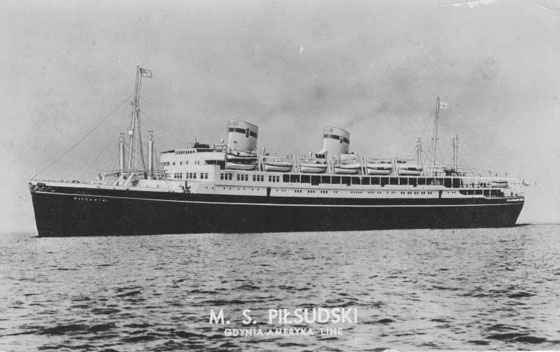
M/S Batory
The Batory was launched on July 3rd 1935, delivered April 3rd 1936 and commenced working the trans-Atlantic Gdynia - Copenghagen - New York run, with the first voyage commencing on May 18th 1936, providing an excellent and popular service. The maiden voyage carried 266 passengers and 307 crew with the running time recorded as seven days 17 hours. On arrival at New York the Assistant Secretary of Commerce Ernest Gallaudet Draper and the President of Vassar College Henry Noble MacCracken made speeches.
An east-west voyage early in June 1937 saw the ship sustain fire damage in the engine room, upon arrival in New York repairs delayed the return sailing for a month. In subsequent sailings the ship was troubled by a series of minor fires.
September 10th 1938: sailed from Gdynia for New York City.
The timetabled July & August 1939 sailings for the Pilsudki & Batory were:
Pilsuski departing Gdynia July 1st, Copenhagen July 2nd, return from New York July 13th.
Batory departing Gdynia July 23rd, Copenhagen July 24th, return from New York August 8th.
Pilsudski departing Gdynia August 11th, Copenhagen August 12th, return from New York August 23rd.
Batory departing Gdynia August 24th, Copenhagen August 25th, return from New York September 6th.
Pilsudski departing Gdynia September 4th, Copenhagen September 5th, return from New York September 17th and Halifax September 18th.
The principal officers on the July 2nd 1939 sailing of the Batory from New York were:
Captain: Eustazy Borkowski
Chief Engineer: Franciszek Bomba
Chief Officer: Franciszek Szudzinski
Chief Purser: Jerzy Sulek
Physician: Dr, Antoni Kutek
On September 5th 1939 the Batory arrived at New York from Gdynia with 642 passengers, including many Polish patriots. After disembarking her passengers the ship remained at anchor on the Hudson following problems with the crew. It had been rumoured that the ship was to be requisitioned by the British Admiralty and used for the transport of munitions from Canada to England, thus placing the ship and its crew in increased danger from submarine attack. Initially 200 crew refused to obey orders, when police were called to the ship the defiant crew members were escorted off the ship leaving about 100 crew members still onboard. The Batory sailed on September 22nd 1939 for a Canadian port.
The wartime travels of the Batory saw the ship survive the conflict, quite remarkable considering the theatres of war that the ship was engaged in. As World War Two commenced the ship was en-route to New York, reaching there on September 5th 1939. During the last week of 1939 it sailed from Halifax to the Clyde. On January 10th the Batory sailed from the Clyde to Suez spending six weeks in the Mediterranean, including two visit to Marseilles before returning to Liverpool on February 22nd 1940.
Early missions during April & May 1940 included the movement of Allied troops, including Poles to Harstad, Norway (convoys NP1 & NP3). Two other Polish passenger ships, several destroyers and at least one submarine took part in this mission. One of the passengers ships, the Chrobry was later sunk by German bombs whilst acting as a troop carrier on her third crossing to Norway, fortunately with very few lives being lost.

After her return from Norway the Batory spent two weeks (June 13th - June 27th) visiting the French ports of St Nazaire, Bayonne & St Jean De Luz to rescue troops from the advancing German forces. Perhaps less dangerous but more historic was the July 4th 1940 sailing from Greenock to Halifax, under a very heavy escort of British capital ships. The Batory was carrying a consignment of historic and irreplaceable Polish artifacts that had originally been housed at Wawel Castle in Krakov. Alongside this treasure was also a large consignment of gold bars being shipped from the Bank of England to the Bank of Canada for safekeeping.
The movement of these national Polish treasures from Krakow to England is in itself a story worthy of James Bond. Time and resources were in very short supply for the keepers of the treasures, the Polish army was initially unable to help, the transport links had been severely compromised by German air raids. With the railways heavily damaged the river/canal system was used to first move the treasures away from Krakow. They journied down the Vistula before transfering to horse and cart to reach Lublin. Despite the recent bombing here the Polish Army was able to provide motor transport allowing them eventually to cross the Dniesti River and into neutral Roumania.
Roumania was no safe haven, the British Embassy provided temporary assistance, a request to the Pope brought no joy and with Hitler asking for the treasures to be impounded, it was time to move on. With the Polish government now in exile in France the treasures were moved by rail to the Black Sea port of Constanza, then by the Roumania freighter Ardeal, which was stopped several times by British warships, before being escorted to the British naval base at Malta. The Roumainan ship was believed to contain barley bound for Germany. A few favours were called in and the ship was allowed to sail on to Genoa and Marseilles, arriving there early in January 1940.
For four months the treasures were held at Aubusson, but with the fall of France the treasures were moved to Bordeaux and then across the English Channel on June 17th 1940 by the Polish freighter Chorzow (on this date the Batory was at St Nazaire). Passengers included many Polish airman eager to fight another day against the Germans. A ship travelling with the Chorzow was hit by a bomb, creating panic in the flotilla of ships, the Chorzow heading off to Falmouth alone. From here the treasures moved to the Polish Embassy in London, clearly not a safe place for anything at this time. They later moved north by rail to Greenock after the Canadian authorities agreed to provide safekeeping for the treasures until hostilities ceased. (Once hostilities ceased the return of the treasures became embroiled in diplomatic and political shenanigans, two decades passing before their return to Poland). On this sailing the Batory reached Halifax on July 12th 1940. It returned to the Clyde on August 1st 1940 as part of convoy TC6.

On August 8th 1940 another mercy sailing commenced, this time from Liverpool to Australia. The purpose was to transport British troops to Singapore and the movement of 480 English children to Australia to avoid the Blitz. The Batory, under the command of Sigismund A. Deycranowski (known to the children as 'Hawkeye'), sailed as part of convoy WS2 (Winston's Specials), seventeen ships protected by a variety of naval vessels throughout the journey. The convoy split in the Atlantic to form a fast & slow section, with the Batory included in the fast section and making eighteen knots when conditions were right. Cape Town had initially been the destination for the children, but they left here on August 31st 1940 for Bombay, Columbo, Singapore, Fremantle, Melbourne & Sydney, arriving here on October 16th 1940 - the ship travelling over 20,000 miles in just over ten weeks. Despite the events elsewhere in a war torn world the upbeat nature of the children during the voyage gave the Batory the name 'the singing ship'. It is reported that food rationing on the Batory was minimal, but there were shortage of fresh water for laundry and other non-food uses. Many ships in the WS2 convoy quickly returned to the United Kingdom, but the Batory would remain for a while in the Far East, including a time dry-docked at Singapore.


After discharging the last of her precious cargo at Sydney the Batory sailed on November 3rd 1940 for Wellington to collect New Zealand soldiers for movement to Suez in convoy US7. Ironically some of the volunteers who had escorted the children from Liverpool transferred here to the Rangitane, another Sulzer engined ship. The Rangitane was headed for London but by the third week of November would be sunk by German raiders three hundred miles out from New Zealand. From Suez the Batory made the long trip round the Cape of Good Hope to reach the Clyde on February 8th 1941.

It was then a trip across the Atlantic to Halifax to return with Canadian troops as convoy TC10 (April 10th - April 19th) to the Clyde, escorts included the battleship HMS Rodney. In the latter half of 1941 the Batory made frequent trips between the Clyde and Liverpool and made at least one return Atlantic crossing to Halifax (October 29th - November 12th), the eastbound sailing as convoy TC14A.
A shortlived convoy was number WS 8C which included the Batory. It was part of an invasion fleet created to seize the Azores islands. The convoy sailed from the Clyde on August 9th 1941 to Scapa Flow, here to await final approval for the mission to begin. The ships remained here until August 15th 1941, at which time the mission was cancelled, the ships then returning to the Clyde to disembark the troops and materials.
The New Year saw the Batory make a round trip from the Clyde to Gibralter before sailing on January 16th 1942 as part of a Russia bound troop movement from the Clyde to Iceland. Its return south was in convoy SD 20 leaving Iceland on January 21st 1942 and reaching the Clyde two days later. The next movement was operation 'Carnival' consisting of two ships, the Batory & the Sobieski, sailing from the Clyde on January 29th 1942 and reaching Gibralter on February 4th 1942. By February 26th the ship was at Lagos, returning to the Clyde by March 14th 1942 as part of convoy MKF10A (from Algiers).

From April 8th to June 10th 1942 the ship made two return Atlantic trips (convoys CT14, NA8, CT16, AT16 & NA10), the second trip including a visit to New York. Then it was with convoy WS20 starting June 21st 1942 from Liverpool to Freetown and then independently on to Lagos, arriving July 12th 1942. Two days later the Batory departed for New York, arriving August 1st 1942.
The Batory sailed with convoy AT 18 from New York on August 6th 1942 and arriving on the Clyde on August 17th 1942 accompanied by eleven ships. Following this the Batory sailed in convoy DS 31 from the Clyde on August 16th 1942 for Iceland, arriving August 18th 1942 with two other ships, presumably as part of a troop movement to Russia. The Batory's return south to the Clyde commenced on August 22nd 1942 in convoy SD 31, reaching the Clyde two days later.
The next five months (November 1942 - March 1943) found the Batory in service in the Mediterranean theatre:
Convoy KMF 1 departed the Clyde on October 26th 1942 with forty ships including the Batory bound for Oran, arriving there on November 8th 1942.
Convoy KMF 4 departed the Clyde on November 27th 1942 bound for Bone with thirty ships including the Batory, whose destination was Algiers, arriving here early in December 1942. The return convoy was MKF 4 departing Algiers on December 10th 1942 with seventeen ships including the Batory, reaching the Clyde on December 18th 1942.
Convoy KMF 7 sailed from the Clyde on January 8th 1943 bound for Algiers with twelve ships including the Batory, arriving on January 17th 1943. Convoy MKF 7 was the return sailing, departing Algiers on January 18th 1943 with eighteen ships including the Batory, dispersing (off the Clyde?) on January 25th 1943.
On February 27th 1943 the Batory sailed from the United Kingdom as part of joint convoy KMF 10A & WS 27, also sailing with this group was the Christiaan Huygens. The convoy split off Gibralter on March 4th 1943 with convoy KMF 10A heading to Algiers including the Batory.
For Operation Husky the Batory and nineteen other ships sailed as convoy KMF 18 from the Clyde on June 28th 1943 and arrived Sicily on July 10th 1943. Departure from here was as convoy MKF 18 with the Batory and twenty two ships, however the Batory detached at Malta and sailed for Alexandria, departing here on July 29th 1943 for a trip through the Suez Canal, arriving at Bombay on August 13th 1943.
On November 5th 1943 the Batory departed Bombay for Basra, Bandar Abbas, Karachi and back to Bombay by December 14th 1943. The Batory left Bombay on December 28th 1943, reaching Port Said on January 17th 1944. Between January 20th 1944 and the middle of October 1944 the ship remained in the Mediterranean supporting troop movements into Italy and Southern France. Ports visited included Taranto, Alexandria, Oran, Naples and Algiers. On October 10th 1944 convoy MKF 35 sailed from Port Said bound for Algiers, Plymouth & Liverpool, arriving there on October 21st 1944. The convoy of seveteen ships included the Batory, Johan Van Oldenbarnevelt & Felix Roussel. The Batory carried 1,756 passengers, presumably troops bound for Cherbourg and the Clyde.
On December 16th 1944 the Batory and fifteen ships departed from the Clyde as convoy KMF 37 arriving Gibraltar on December 21st 1944, the Batory carried 1,265 troops, later going forward along with seven other ships to Bombay and Kilindini, arriving at the latter on January 21st 1945. The Batory returned to Aden as part of convoy CM59C, arriving Aden January 30th 1945. It was then on to Gibralter to load 900 troops to join convoy MKF 39 which sailed on February 14th 1945 with nineteen ships, bound for Liverpool, arriving February 20th 1945.
The formal end of the war in Europe in April 1945 did not see the immediate release of the Batory from its troop carrying duties. It visited Iceland on June 9th, Funchal on June 24th and Naples on July 1st 1945 before returning to the Clyde. The remaining six months of 1945 were spent in the Mediterranean, returning to the Clyde on December 28th 1945.
On March 17th 1946 the Batory arrived at Glasgow with 1,500 troops and Royal Air Force personnel from Bombay. A case of samallpox was identified requiring all on board the ship to be vaccinated.
Post World War Two Service
After release from its military duties the Batory returned to its former haunts, it received a refit from April 1946 to March 1947 at Antwerp, somewhat delayed by a shipboard fire whilst being refitted. The ship was now configured to carry 450-1st and 450-tourist class passengers. It is recorded as sailing from Southampton on April 5th 1947 (its first voyage after the refit?). On the North Atlantic run the Batory was a regular visitor to Gdynia, Copenhagen, Southampton & New York. During the early days of the Cold War the ship was embroiled in a series of incidents, which led to the port authority in New York refusing to handle the ship. Since 1947 the ship had been under the control of Communist authorities, the Urzad Bezpieczenstawa (UB) and to a lesser extant the communist United Polish Workers Party. The Captain of the Batory was now little more than its chaffeur; Peter Szemiel, the second in command, whose position included the title Cultural Officer was the real master of the ship. Third in command was Kaminski, a captain in the UB, always in touch with Warsaw and the creator of a large spy network thoughout the ship. The effects on the crew were dramatic, over 100 crewman deserted in response to the new regime. For those who deserted but were caught their fate was not pleasant.
Many stories abound in the press about the searches carried out to the Batory when she arrived in New York. Worse occurred on the ship's return to Gdynia, the ship could not dock until the UB and Frontier Guard had come aboard, met with Szemiel & Kaminski, and thoroughly searched the ship, the crew being detained in the dining room until the searches were completed. Those found harbouring subversive Western materials recieved a black mark on their record if it was a first offence, a second offence saw the crew person dismissed from the service.
July 27th 1947: the Batory's doctor was transferred to the vessel American Farmer after the latter sent out an SOS requiring medical assistance for a pregnant woman. The location was about 180 miles off Lands End. Despite heavy fog the American Farmer was able to reach Falmouth and transport the pregnant lady to the local hospital.
February 19th 1949: whilst docked at New York nineteen seamen deserted according to immigration officials.
On May 14th 1949 the man described by the United States Congress as America's No.1 communist, Gerhart Eisler, was arrested aboard the Batory by Scotland Yard detectives as it arrived at Southampton. Eisler had been sentenced in the USA to a three year prison term related to his Communist activities (allegedly the covert leader and director of the Communist Party in America), but was released on bail of $23,500. With his legal appeals failing with regard to passport fraud and contempt of Congress, he jumped bail and using a 25 cent visitors ticket gained access to the Batory, which departed New York on May 6th. Eisler was initially held at Southampton police station pending movement to London and extradition proceedings at Bow Street Court. The extradition request failed and British authorities eventually allowed him to leave for the German Democratic Republic. The Batory reached Gdynia on May 19th where a Polish inquiry commenced with regard to the recent events in Southampton. On the return sailing of the Batory to New York in early June 1949, arriving New York June 4th (?), the ship underwent intensive investigation by Federal agents on arrival in New York and remained under heavy guard (30 armed US Border Patrolmen) whilst in the port of New York. The 110 passengers were detained at Ellis Island for immigration screening whilst three senior crew and the Captain were removed from the ship and interviewed by immigration officers, it being alleged that the three officers were involved in the obtaining of the ticket and cabin for Gerhart Eisler on the previous trip. The 'detained' crewmen were returned to the ship prior to its eastbound sailing. It is also reported that the Batory had been used to transport Boleslaw Gebert & Leo Krzycki out of the USA, both were notorious members of the Communist Party, being very active in the USA.
March 1950: the Batory was used to transport convicted Russian spy Valentin Gubitchev from New York to Gdynia. His fifteen year sentence was suspended on the condition that he never returned to the United States.
May 16th 1950: Soviet Ambassador to the United States Alexander Panyushkin, utilised the Batory to return to Russia for two months rest under a doctor's care.
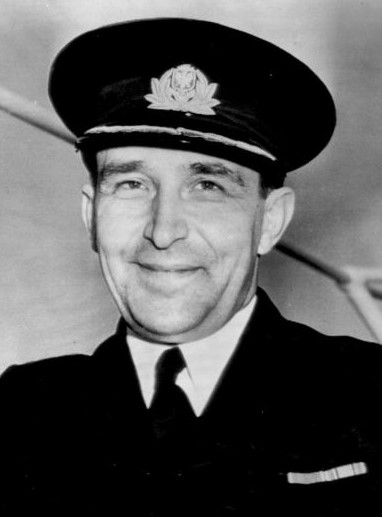 |
List of senior officers on the Batory on the North Atlantic sailing from Gdynia Tuesday, July 25th 1950; Copenhagen, Wednesday, July 26th & Southampton, Friday, July 28th to New York:
Master Jan Cwiklinski (pictured) When the above voyage reached New York on August 5th 1950 Customs officials searched the ship as part of the first 'Trojan ship' examination as required by Federal authorities. The ship was searched for atomic weapons and communist personnel. A similar search was carried out on October 9th 1950 with the Customs officials using 'special instruments' in their search.
|
August 16th 1950: on arrival at Southampton two Americans were removed from the Batory. Howard Campbell was identified as a stowaway, whilst William Newton had been rescued after his seaplane touched down alongside the ship when it was about 75 miles out from New York. Newton was later charged with transporting an aircraft in foreign commerce knowing it had been stolen. His bail was fixed at US$50,000 dollars. The seaplane, valued at US$ 2,600 was claimed by the Batory as salvage and left in England.
September 12th 1950: New York longshoreman refused to load cargo on to the Batory, included in the cargo were 86 cases of streptomycin, stated to be for the treatment of tubercular children. The ship sailed with 542 passengers but no cargo.
October 10th 1950: Czeslan Grzelak, vice-president of Gdynia America Lines and operator of the Batory was placed aboard the Batory for deportation to Poland. Grzelak had entered the United States in 1940, was deported on the grounds that he was a member of a communist organisation.
February 1st 1951: American shipwrights refused to carry out repairs to the Batory whilst docked in New York.
Effective April 1st 1951 the Batory would be refused access to the port of New York, leading to the Batory commencing a new service during September1951 from Poland to India & Pakistan via the Suez canal. This service was eventually stopped by the Suez crisis and the closure of the canal in 1956. In retaliation the Polish authorities banned the American Scantic Line from access to Polish ports. The first sailing commenced September 17th 1951 travelling via Southampton, Gibraltar, Port Said, Suez, Aden & Bombay.
Prior to taking up the Poland - India runs, during August 1951 the Batory worked several shuttles between Calais & Dunkirk to Gdynia, Poland, taking many young people to the Communist World Youth Festival in Berlin. At this time the British and American authorities were impeding the movement of Western communists into East Germany.
During May 1953 the Batory was received at Hebburn on Tyne for dry-docking and a refit. Whilst here Jan Cwiklinski, master of the Batory since 1946, left the ship during July with the intent to seek political asylum in England, believing that when the ship reached Gdynia he would be arrested by the authorities. The Captain knew that he had been under surveillance for awhile and had very recently received several warnings that on his return to Gdynia he would be placed under arrest with a trial to follow. The Captain and crew frequently visited Newcastle during the stay of the Batory, these visits were also monitored by the Polish Secret Police. Late in June, with the sailing of the Batory imminent, the Captain made one of his regular trips into Newcastle city center. He found a car-hire firm that would drive him to Darlington, taking lunch here before catching an express train headed for London. At Peterborough the Captain changed to a local stopping service, disembarking at Finsbury Park, then getting a taxi to a friend's house. A visit was then made to a local police station to formally request asylum. The Captain was transferred to Brixton prison for two days whilst the asylum request was completed. Independently the Batory's Medical Officer had also requested asylum. The story broke when the British pilot returned to Newcastle after taking the ship out of the Tyne, noting that the Captain was missing. Jan Cwiklinski never returned to his native Poland, his family would be harassed by Polish Communists and the Security Services. He eventually emigrated to the United States, receiving citizenship in 1960.
January 26th 1954: former Batory master Jan Cwiklinski was expected to arrive in the United States on a temporary lecture tour.
April 13th 1954: the Pakistan cricket team departed Karachi for England on the Batory. Southampton was reached on May 4th in some stormy weather. The Pakistan cricket team would return to Pakistan on the Batory late in September.
October 28th 1954: whilst sailing westbound north of Tobruk the Batory was hit by two tremendous waves, reportedly 20 feet high, sweeping three seamen overboard to their deaths and fatally injuring a fourth.
After a refit in 1957 at Bremerhaven when the accomodations were changed (76 first class & 740 tourist class), the ship returned to the North Atlantic route with Montreal the port of choice now rather than New York, her first working on this route commenced during the first week of September 1957. During the summer months Montreal & Quebec were the destination ports, during the winter it was left for Halifax to handle the Batory. By the 1960's the time was running out for these trans-Atlantic workings with air travel taking away the bread & butter of the passenger shipping lines.
On December 28th 1965 the Batory arrived in Boston with 548 'Iron Curtain' immigrants on board, the largest group to arrive at a United States port since World War Two.
Early in December 1968 the Batory made her last regular trans-Atlantic crossing, whilst during the middle of February 1969 the Batory receiving a farewell ceremony at Tilbury on February 20th, which included some of the people who had been evacuated to Australia as children on the Batory during the Blitz.
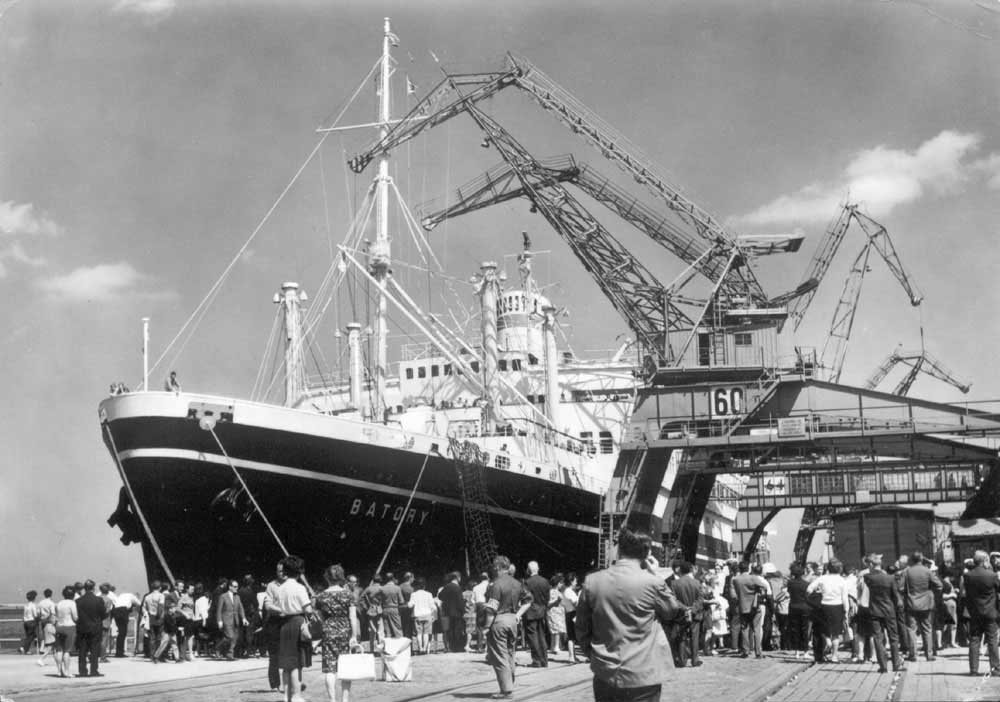
Afer retirement the Batory, like a number of other ships became a floating hotel-restaurant-museum, for the Batory it was in Gdynia for two years. But like most of these ventures the great idea proved unprofitable, the ship was sold for US$570,000 to a Hong Kong scrap yard, making her last oneway voyage during 1971.
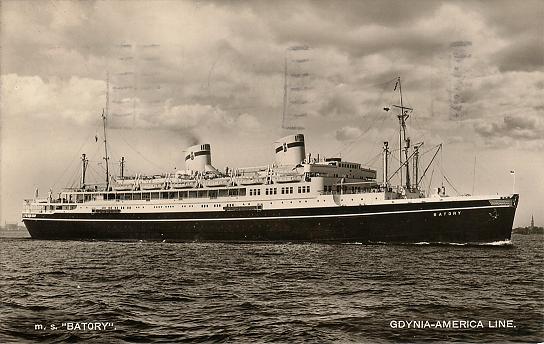
Built: Cantieri Riuniti del Adriatico Shipyard, Triest-Monfalcone, Italy 1934 - 1936
Launched: 1935/1936
Gross Tons: (Pilsudski) 14,294 tons; (Batory) 14,287 tons
Length: 526 feet
Breadth: 70 feet
Draught: 24 feet
Propulsion: 2 x Sulzer 9 cylinder engines totalling 12,500hp
Screws: 2
Speed: 18 knots
Passengers: (1939) 770 (first class 280, third class 415, interchangeable 75)
Passengers: (date??) 796 (first class 46, second class - tourist 370, third class 400)
Crew: 350
Resources:
National Library of Australia : Trove website of archived Australian Newspapers (trove.nla.gov.au)
ConvoyWeb (website): Data supplied by Don Kindell, extracted from the late Arnold Hague's papers with the kind permission of Mrs. Gill Hague.
The Singing Ship: an odyssey of evacuee children, Meta Maclean, Angus and Robertson, Sydney. 1941
The Captain Leaves His Ship: Jan Cwiklinski & Hawthorne Daniel, Doubleday 1955
August 2020: A 35mm colour slide from September 1966 showing a side view of the Batory in Canada sold on Ebay for US$157.50.
Page added February 22nd 2006
Last updated January 15th 2025
Return to Ship menu
Return to site menu